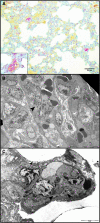Pathogenic mechanisms implicated in the intravascular coagulation in the lungs of BVDV-infected calves challenged with BHV-1
- PMID: 23506546
- PMCID: PMC3618313
- DOI: 10.1186/1297-9716-44-20
Pathogenic mechanisms implicated in the intravascular coagulation in the lungs of BVDV-infected calves challenged with BHV-1
Abstract
Resistance to respiratory disease in cattle requires host defense mechanisms that protect against pathogens which have evolved sophisticated strategies to evade them, including an altered function of pulmonary macrophages (MΦs) or the induction of inflammatory responses that cause lung injury and sepsis. The aim of this study was to clarify the mechanisms responsible for vascular changes occurring in the lungs of calves infected with bovine viral diarrhea virus (BVDV) and challenged later with bovine herpesvirus type 1 (BHV-1), evaluating the role of MΦs in the development of pathological lesions in this organ. For this purpose, pulmonary lesions were compared between co-infected calves and healthy animals inoculated only with BHV-1 through immunohistochemical (MAC387, TNFα, IL-1α, iNOS, COX-2 and Factor-VIII) and ultrastructural studies. Both groups of calves presented important vascular alterations produced by fibrin microthrombi and platelet aggregations within the blood vessels. These findings were earlier and more severe in the co-infected group, indicating that the concomitance of BVDV and BHV-1 in the lungs disrupts the pulmonary homeostasis by facilitating the establishment of an inflammatory and procoagulant environment modulated by inflammatory mediators released by pulmonary MΦs. In this regard, the co-infected calves, in spite of presenting a greater number of IMΦs than single-infected group, show a significant decrease in iNOS expression coinciding with the presence of more coagulation lesions. Moreover, animals pre-inoculated with BVDV displayed an alteration in the response of pro-inflammatory cytokines (TNFα and IL-1), which play a key role in activating the immune response, as well as in the local cell-mediated response.
Figures








Similar articles
-
Response of proinflammatory and anti-inflammatory cytokines in calves with subclinical bovine viral diarrhea challenged with bovine herpesvirus-1.Vet Immunol Immunopathol. 2011 Nov 15;144(1-2):135-43. doi: 10.1016/j.vetimm.2011.07.022. Epub 2011 Aug 4. Vet Immunol Immunopathol. 2011. PMID: 21856021
-
Comparison of pathological changes and viral antigen distribution in tissues of calves with and without preexisting bovine viral diarrhea virus infection following challenge with bovine herpesvirus-1.Am J Vet Res. 2013 Apr;74(4):598-610. doi: 10.2460/ajvr.74.4.598. Am J Vet Res. 2013. PMID: 23531068
-
Characterization of thymus atrophy in calves with subclinical BVD challenged with BHV-1.Vet Microbiol. 2015 May 15;177(1-2):32-42. doi: 10.1016/j.vetmic.2015.02.018. Epub 2015 Feb 26. Vet Microbiol. 2015. PMID: 25759294
-
A review of the biology of bovine herpesvirus type 1 (BHV-1), its role as a cofactor in the bovine respiratory disease complex and development of improved vaccines.Anim Health Res Rev. 2007 Dec;8(2):187-205. doi: 10.1017/S146625230700134X. Anim Health Res Rev. 2007. PMID: 18218160 Review.
-
Maternal antibody blocks humoral but not T cell responses to BVDV.Biologicals. 2003 Jun;31(2):123-5. doi: 10.1016/s1045-1056(03)00027-7. Biologicals. 2003. PMID: 12770543 Review.
Cited by
-
Global Transmission, Spatial Segregation, and Recombination Determine the Long-Term Evolution and Epidemiology of Bovine Coronaviruses.Viruses. 2020 May 13;12(5):534. doi: 10.3390/v12050534. Viruses. 2020. PMID: 32414076 Free PMC article.
-
The Cell-Mediated Immune Response against Bovine alphaherpesvirus 1 (BoHV-1) Infection and Vaccination.Vaccines (Basel). 2023 Apr 2;11(4):785. doi: 10.3390/vaccines11040785. Vaccines (Basel). 2023. PMID: 37112697 Free PMC article. Review.
-
Immune protection induced by E2 recombinant glycoprotein of bovine viral diarrhea virus in a murine model.Front Vet Sci. 2023 Jun 22;10:1168846. doi: 10.3389/fvets.2023.1168846. eCollection 2023. Front Vet Sci. 2023. PMID: 37426077 Free PMC article.
-
A subunit vaccine candidate based on the Spike protein of SARS-CoV-2 prevents infectious virus shedding in cats.Res Vet Sci. 2022 Nov;148:52-64. doi: 10.1016/j.rvsc.2022.05.003. Epub 2022 May 29. Res Vet Sci. 2022. PMID: 35667227 Free PMC article.
-
Pathogenesis, Host Innate Immune Response, and Aerosol Transmission of Influenza D Virus in Cattle.J Virol. 2019 Mar 21;93(7):e01853-18. doi: 10.1128/JVI.01853-18. Print 2019 Apr 1. J Virol. 2019. PMID: 30674628 Free PMC article.
References
-
- Barrett DC. Bovine respiratory disease-A clinician’s perspective. Cattle Pract. 1998;6:251–255.
-
- Caldow G, Nettleton P. Pneumonia: identifying the causal agent. Cattle Pract. 2000;8:131–134.
-
- Griffin D. Economic impact associated with respiratory disease in beef cattle. Vet Clin North Am Food Anim Pract. 1997;13:367–377. - PubMed
-
- Fulton RW, Purdy CW, Confer AW, Saliki JT, Loan RW, Briggs RE, Burge LJ. Bovine viral diarrhea viral infections in feeder calves with respiratory disease: interactions with Pasteurella spp., parainfluenza-3 virus, and bovine respiratory syncytial virus. Can J Vet Res. 2000;64:151–159. - PMC - PubMed
-
- Fulton RW, Blood KS, Panciera RJ, Payton ME, Ridpath JF, Confer AW, Saliki JT, Burge LT, Welsh RD, Johnson BJ, Reck A. Lung pathology and infectious agents in fatal feedlot pneumonias and relationship with mortality, disease onset, and treatments. J Vet Diagn Invest. 2009;21:464–477. doi: 10.1177/104063870902100407. - DOI - PubMed
Publication types
MeSH terms
LinkOut - more resources
Full Text Sources
Other Literature Sources
Research Materials

